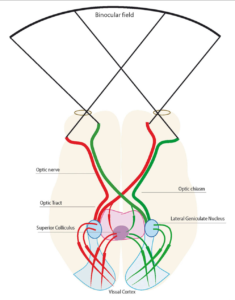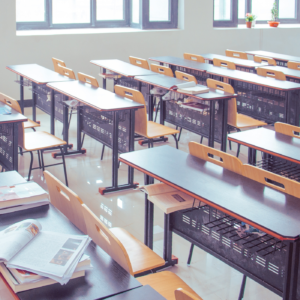What is Binocular Vision Dysfunction (BVD)?
Before discussing BVD, it is important to understand what binocular vision is. Bi- means both and -ocular means eyes, so binocular vision means seeing with both eyes. In their post about binocular vision, Vivid Vision¹ discusses how the brain receives separate signals from both eyes, and combines them together in order to see. We can generally coordinate our eye movements when both eyes are well-functioning. Additionally, both eyes see slightly different visual fields, which is why we have depth perception. When the eyes are functioning well this all works seamlessly, but when the eyes do not properly align or team, a number of uncomfortable symptoms can occur.
According to the Dizziness and Headache Optometry Center², binocular vision dysfunction is “…an ocular condition that occurs when the eyes don’t align properly with one another”. Symptoms of BVD result when our brain tries to correct or compensate for this misalignment, which can take a substantial amount of effort.

Types of BVD³
- Vertical Heterophoria
- A vertical misalignment of the eyes
- Esophoria or Exophoria
- Tendency for the eyes to drift inward (eso) or outward (exo) during certain tasks
- Convergence Insufficiency
- The inability to turn the eyes inward and keep single vision at a near point
- The #1 cause of eye strain
- Convergence excess
- Divergence excess
- Divergence insufficiency
Signs and Symptoms of BVD
- Double vision or blurred vision
- Fatigue when reading or doing computer work
- Poor balance or coordination
- Nausea or motion sickness
- Poor depth perception
- Pain in the eyes, neck, back, or face
- Head tilt
- Headaches or migraines with near work
- Anxiety in crowds or large spaces
- Restless sleep
- Difficulty with comprehension and attention
How Vision Therapy can help treat BVD
In his editorial piece “The Binocular Vision Dysfunction Pandemic”, Dominick M. Maino, OD, MEd, FAAO, FCOVD-A writes that “…Evidence based medicine has shown that the best and most efficacious treatment for convergence insufficiency (a type of binocular vision dysfunction) is office-based optometric vision therapy”. He describes how most other binocular vision dysfunction disorders would also benefit most from vision therapy.
Dr. Maino provided plenty of support for his findings through textbooks, case reports, studies, and other qualified individuals: “Dennis Levi, OD, PhD, Dean of the Optometry School at Berkeley, noted that perceptual learning (vision therapy) is a quite successful intervention if it is intensive, engaging and appropriately challenging”.
Those who have binocular vision issues due to brain injuries, autism, or other developmental, genetic, or intellectual disabilities can also greatly benefit from vision therapy.
If you suspect you or your child may have Binocular Vision Dysfunction, contact our office to schedule an appointment at
https://www.visualintegrationcenter.com/request-appointment/
Sources:
Vivid Vision
https://www.seevividly.com/info/Binocular_Vision
Dizziness and Headache https://www.dizzinessandheadache.com/blog/what-causes-binocular-vision-dysfunction.html#:~:text=Binocular%20vision%20dysfunction%20is%20an,are%20associated%20with%20the%20condition
https://www.dizzinessandheadache.com/binocular-vision-dysfunction.html
The Binocular Vision Dysfunction Pandemic
https://cdn.ymaws.com/www.covd.org/resource/resmgr/ovd41-1/editorial_binocularpandemic.pdf
What is Vision Therapy?
Vision Therapy is a specialized field of optometry that works on developing and enhancing basic visual skills, therefore allowing vision to become more comfortable and efficient. Furthermore, vision therapy positively influences vision thinking skills by improving eye-brain connections.
What We Treat
At our office, we provide treatment for a variety of vision issues through the use of specific procedures programmed by Dr. Gates. Examples of vision issues include
- Amblyopia (lazy eye)
- Strabismus (eye turn)
- Blurred or double vision
- Eye tracking or teaming
- Eye-body coordination
- Visual thinking and information processing
Before beginning therapy, Dr. Gates will perform evaluations to determine the best course of action for the patient. During a patient session, Dr. Gates and the vision therapists work together with the patients on activities that target their specific visual needs.
What Vision Therapy Can Do for You
-
- Reduce or eliminate visual deficiencies
- Improve work and classroom performance
- Aid in reading and writing skills
- Aid in perceptual skills
- Aid in attention and focusing
- Relieve symptoms like eye strain or fatigue, headaches, or stress through the use of light therapy
- Overall, improve integration of the visual system with the body and mind
How Do I Know If Vision Therapy Is Right for Me or My Child?
According to COVD.org, 1 in 10 children have a vision problem significant enough to impact learning, and normal eye screenings can miss up to 50% of visual problems. Eyeglasses, medication, and surgery can sometimes help visual issues, but are not always the answer to improving basic visual skills.

If you suspect you or your child may need vision therapy, contact our office to schedule an appointment at: https://www.visualintegrationcenter.com/request-appointment/
Explore some common symptoms caused by vision problems here: https://www.covd.org/page/Symptoms
Check out our blog post “Vision Therapy is Not Just for Kids” to learn why vision therapy can benefit everyone: https://www.visualintegrationcenter.com/vision-therapy-is-not-just-for-kids/
What is Your Learning Style?
Did you know that there are different ways of learning?
There are 3 main learning styles. Everyone is going to learn slightly differently. Knowing how you or your child learns best gives you the tools to help you to succeed.
The 3 main learning styles are:
Auditory: Learning by hearing and listening.
Visual: Learning by reading or seeing pictures.
Tactile: Learning by touching and doing.
All individuals will be a combination of each of these. You will have some ways of learning that will be easier for you and some that will be more challenging. An example would be an individual who is 65% tactile, 25% visual, and 10% auditory. So to support their most appropriate mode of learning, they should be encouraged to move and be physically involved in the learning. The auditory score being so low means that it is a struggle for this individual to learn just from someone talking or listening to something. They may have to work a lot harder to learn using only an auditory-style of learning. However if they were able to include tactile or visual aspects, this may allow for easier learning.
If this individual were listening to a lecture, and taking notes, they may struggle to retain a lot of the information being given. However, if they color code or draw pictures in their notes that may help them to better understand and remember what is being said. Then they can review the notes later and will have the visual clues in the colors and pictures added into the notes.
Do you know how you/your children learn best?
Would you like to? Click HERE to answer a 20 question Questionnaire, where there are no right or wrong answers. The website will break down what percent out of 100 you are with each of the three styles of learning.
After you finish the questionnaire the website will explain each one in more detail as well as give examples of ways to learn more efficiently. Below are a few examples of ways to utilize your preferred learning style to your benefit, by Dr. Michael W. Kirst of Stanford University.
Visual– Draw pictures and diagrams in the margins while reading and write out questions you are working on. Underling and highlight text as you read and make flashcards for studying (use different colored cards). Copy over your notes to help with recall. Preview a chapter before reading it by first looking at the pictures and section headings.
Auditory – Listen to the words you read and read aloud or talk through the information. Record lectures, tutoring and study group sessions, etc. Make up and repeat rhymes to remember facts, dates, and names. Study in groups and particulate in class discussions and debates. Have a friend or classmate quiz you on vocabulary words and recite the word and definition out loud frequently. After you read a section, summarize it out loud.
Tactile/Kinesthetic – Walk around as you read and listen to recordings of lectures and notes. Engage your fingers while studying by tracing words and re-writing sentences to learn key facts. If you have a stationary bicycle, try reading while pedaling and studying with music in the background. Try squeezing a Nerf ball or bouncing a foot on the floor.
Just because you know your learning style does not automatically mean you will be able utilize it to its fullest potential. In our office we see people with a wide range of visual difficulties. Quite a few of our patients could be primarily visual learners due to the way their brain is wired. However if the eyes are not working quite right it can greatly impact the ability to learn at the highest potential.
